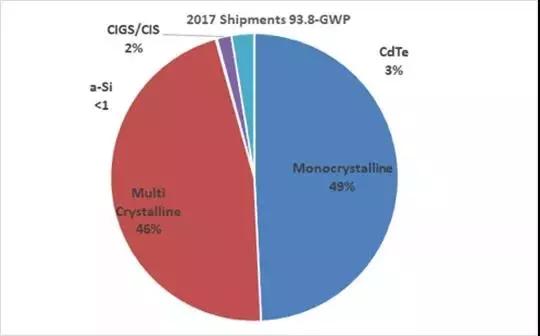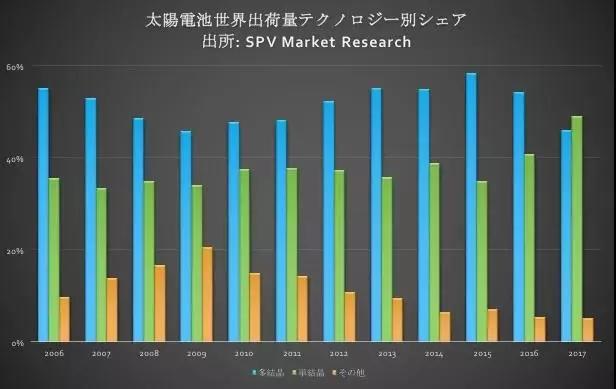"Single crystal" share rose to 49%
In 2017, the shipment of “monocrystalline silicon†solar panels surpassed “polysilicon†for the first time. The US solar power market research consultancy spv reached this conclusion in the solar power market report released in December 2017.
At the beginning of 2000, Japanese companies such as Sharp, Kyocera, and Mitsubishi Electric were leading companies in the solar power generation market. At that time, the mainstream components (panels) were polysilicon. At that time, although the monocrystalline silicon type was highly efficient, the low-priced "polysilicon type" showed an advantage in the price competition. However, after that, the “single crystal type†gradually expanded its market share and eventually took the championship.
According to the report, the production capacity of solar cells (power generation components) in 2017 was 97.7 GW, of which 93.8 GW was shipped, and its installation capacity was 95.1 GW. According to the occupancy analysis of component types, the market share of single crystal silicon type is 49%, the polycrystalline silicon type is 46%, and the compound type cadmium telluride (CDTE) type is 3% (93.4 GW). figure 1).

Figure 1: Solar PV panel shipments (shipments) in the world's photovoltaic power generation market in 2017 (Source: SPV Market Research)
Launch of the "super" component
In 2016, the polysilicon market share was 54%, which was 13% higher than single crystal and stayed ahead. However, by 2017, the share of monocrystalline silicon type was 3 percentage points higher than the polycrystalline type, which was the first reversal (Figure 2).

Figure 2 Market share trends of solar panel types and types of photovoltaic power generation in the world (2006-2017) (Source: SPV Market Research )
The report believes that the main reason for the increase in the market share of monocrystalline silicon is that component manufacturers have turned to high-end components. One of them is the p-type monocrystalline silicon "emitter and back passivated battery technology (PERC)" that component manufacturers began mass production in 2016. PARC's commercial production expanded in 2017, and increased efficiency while reducing prices contributed to the increase in market share.
In 2015, Sunbackower's "BackContact (IBC)", Panasonic's heterojunction (HIT) solar panels, and South Korea's LG's solar panels showed high prices on the market. In addition, the market is expected to increase the use of panels of n-type single crystal silicon having high conversion efficiency.
In 2016, P-type single crystal and polycrystalline solar cell production capacity is shifting significantly to PERC technology. "The price decline occurred in the third quarter of 2013, and the high price of n-type solar cells prompted solar cell manufacturers to switch to p-type single-crystal silicon," said Paula Mintz, chief market research analyst and founder of SPV Market Research.
What is the result of "n-type" vs "p-type"?
Mintz pointed out that the production of n-type monocrystalline silicon requires high quality materials and silver paste, which makes production costs more expensive than other technologies. The competition in the photovoltaic power generation industry has always been based on price, and aggressive price setting is considered to be a common means of competition. “Although we will further increase the share of n-type monocrystalline silicon with high conversion efficiency, we will not occupy the highest share.â€
In addition, the single-crystal silicon type "n-type" module has a shipment share of 38%, and the remaining 62% is "p-type". Although the market share of “n-type†and “p-type†in 2017 has not yet been disclosed, the market share of “p-type†is expected to increase significantly.
According to Mr. Mintz, at present, the first shipment of n-type single-crystal silicon panels is the US sunpower company, but Korean companies are expanding their market share.
It is understood that the current production of p-type monocrystalline silicon panels ranks first in China's Jingke Energy. On November 8, 2017, the company announced that P-type single crystal PERC solar cells reached the world's highest conversion efficiency of 23.45%. According to a spokesperson for the company, PERC is becoming a mature technology and it is expected that the production scale will further expand in 2018.
The Emergency Sensor Light is specially designed for ceiling Mounted emergency lighting and with Microwave Sensor. from 12inch 18W to 18inch 36W. Dimmable lighting, Waterproof and Dustproof avialable. Widely using for Office and Household. Automatically light at once when buildings main power outage. It is more than 3 hours emergency time. When Main power is on, it use as an normal sensor lighting
Led Emergency Sensor Light,Emergency Light Sensor,Microwave Sensor Emergency Light,Emergency Sensor Light
Foshan Nai An Lighting Electric Co.,ltd , https://www.fsnaipsled.com
